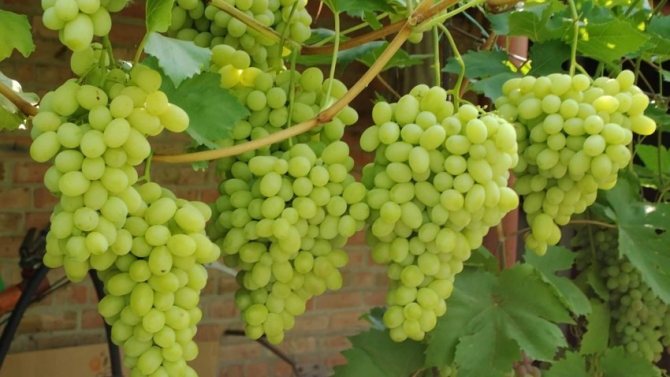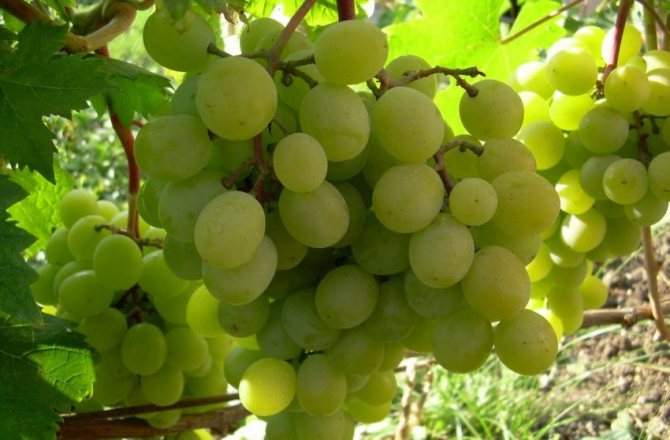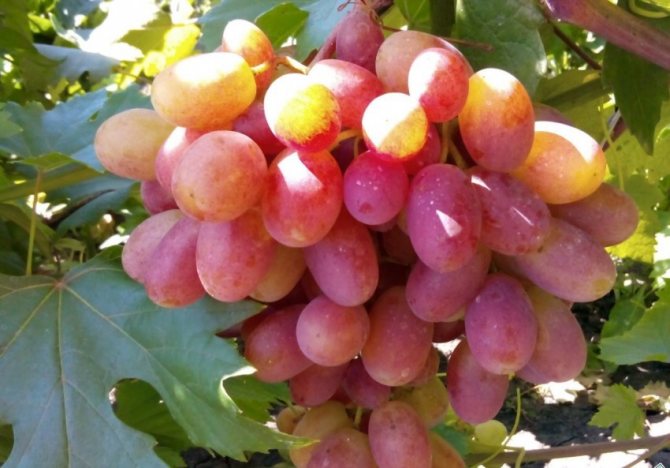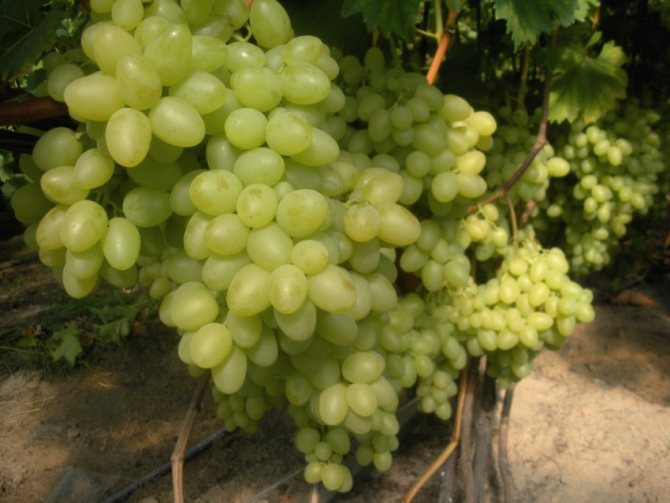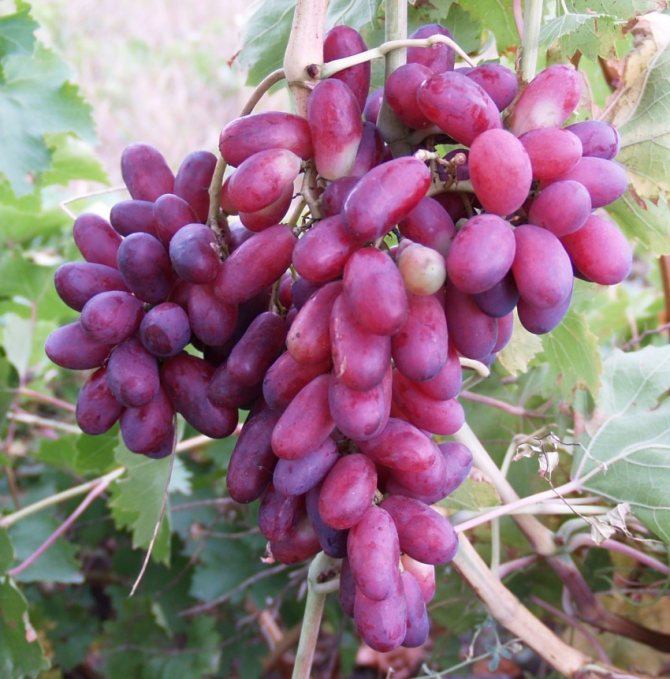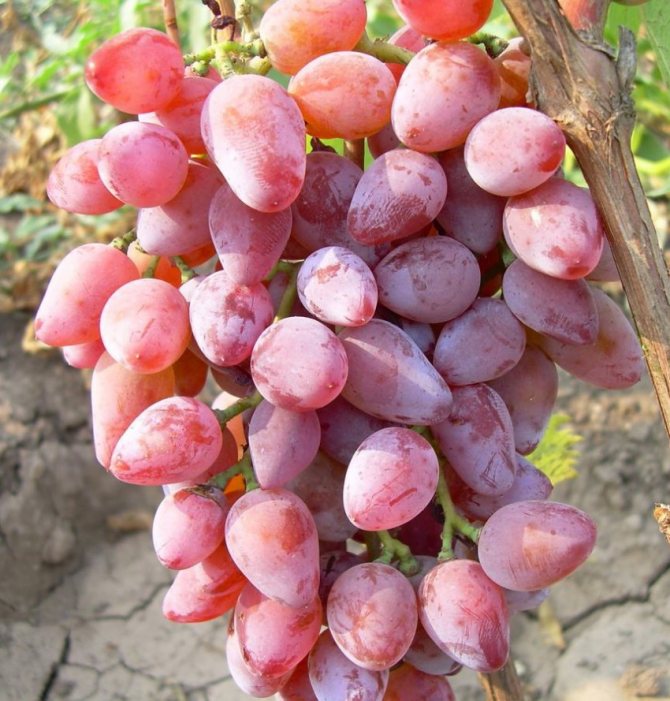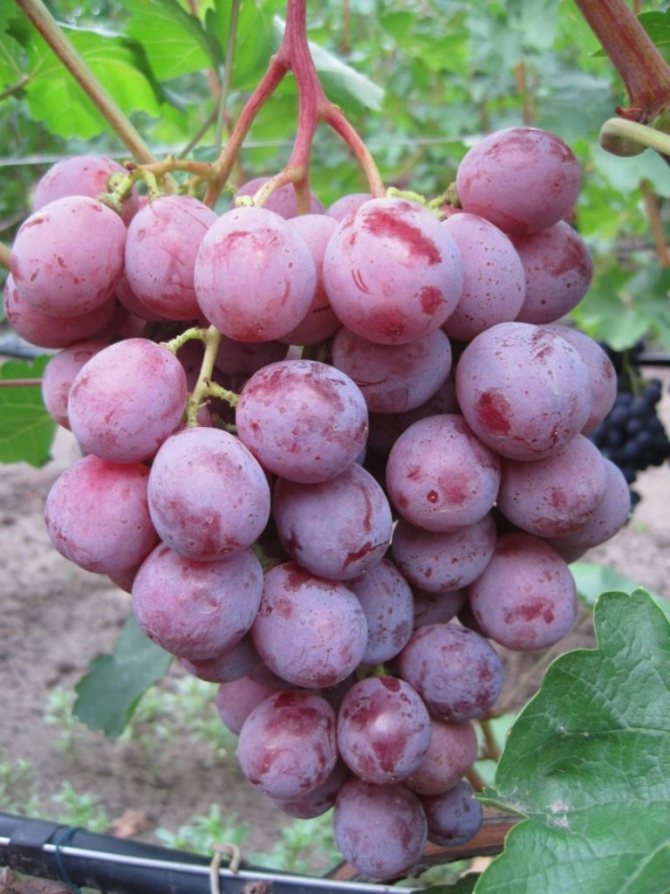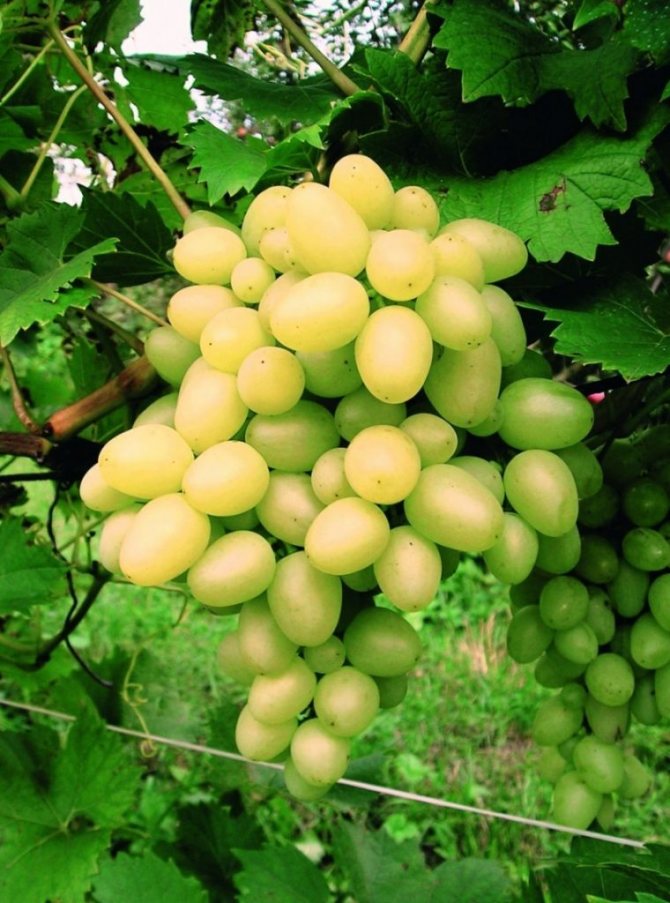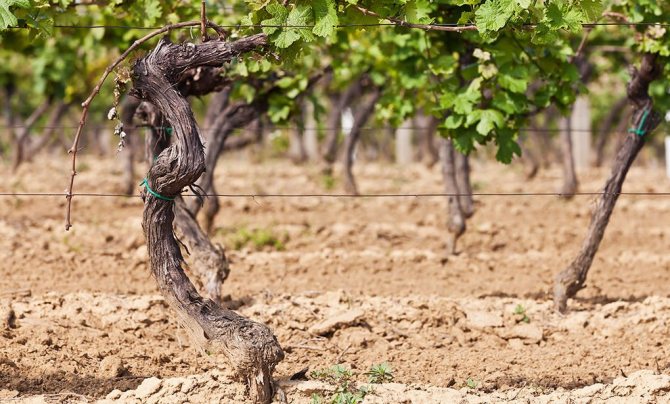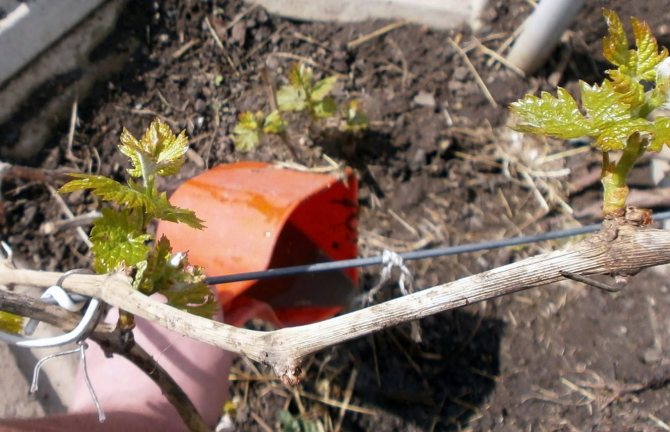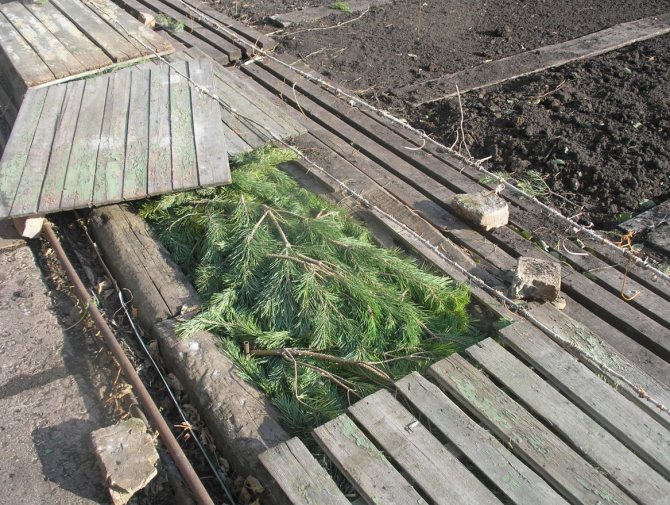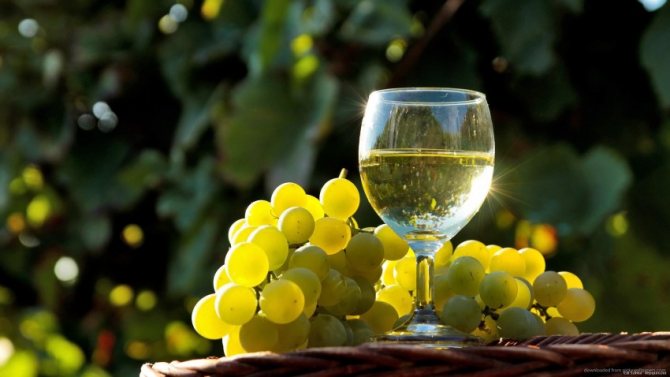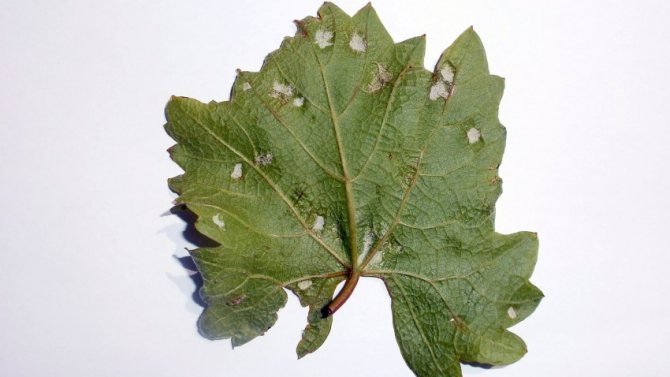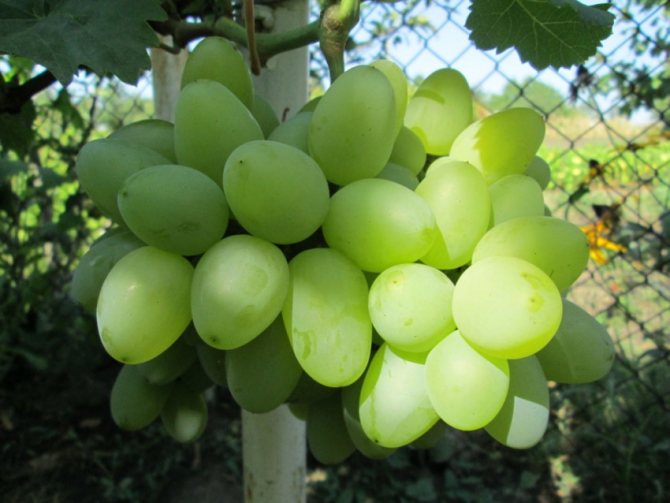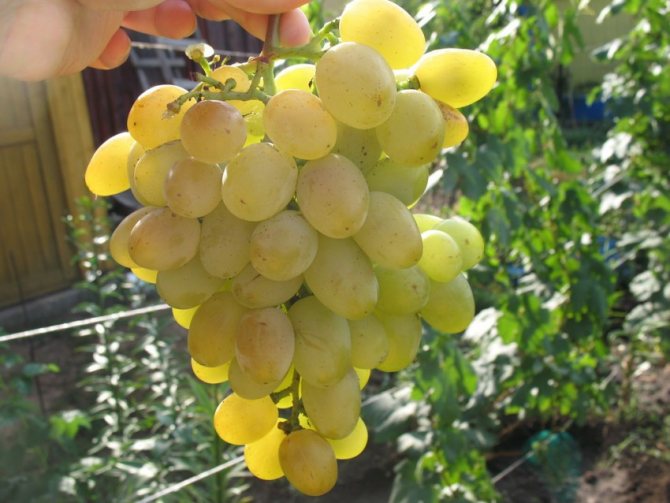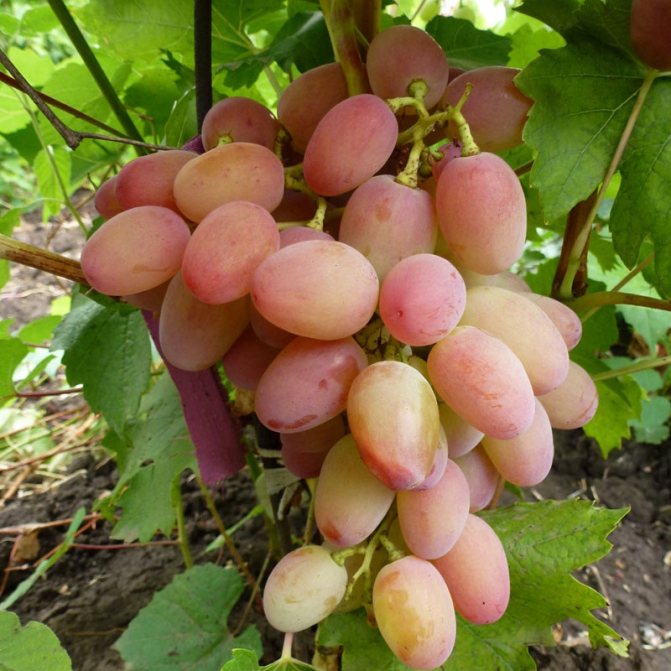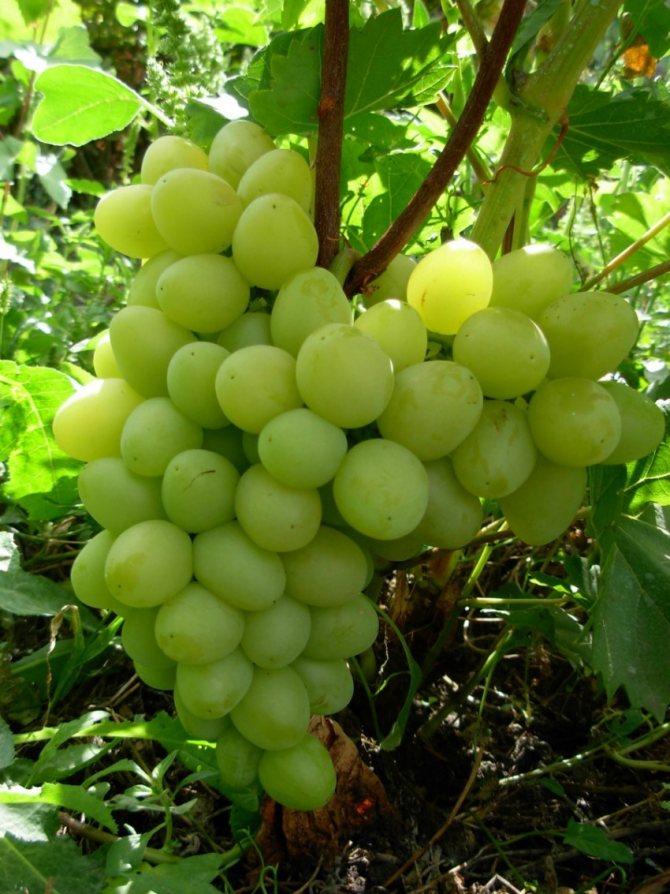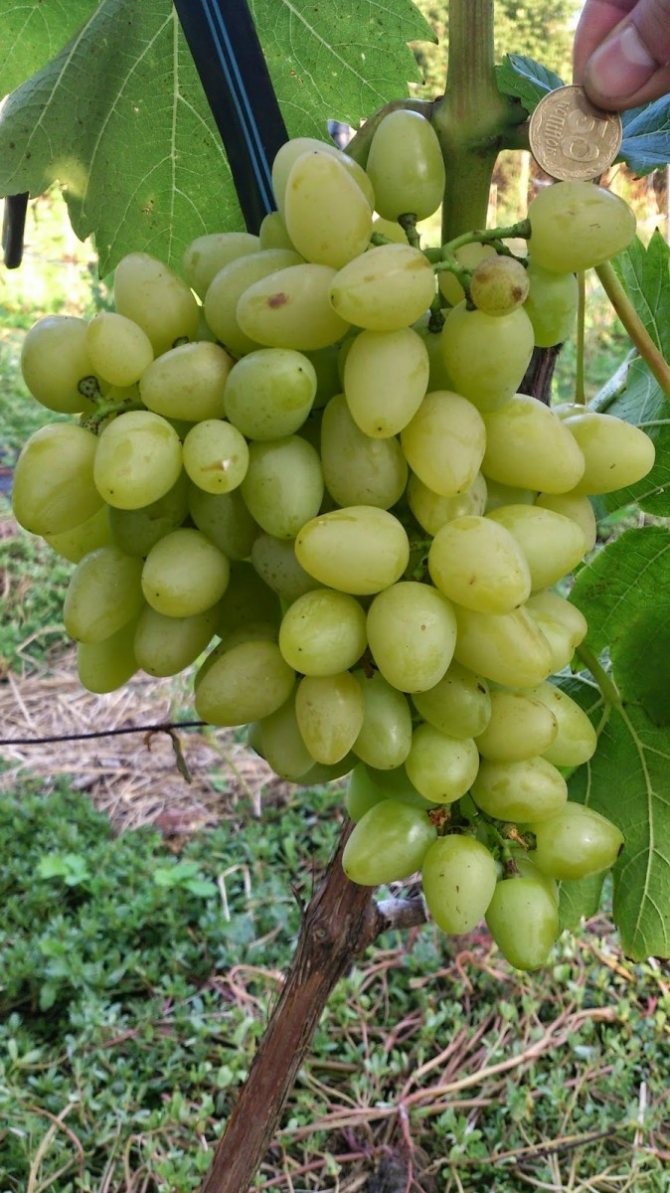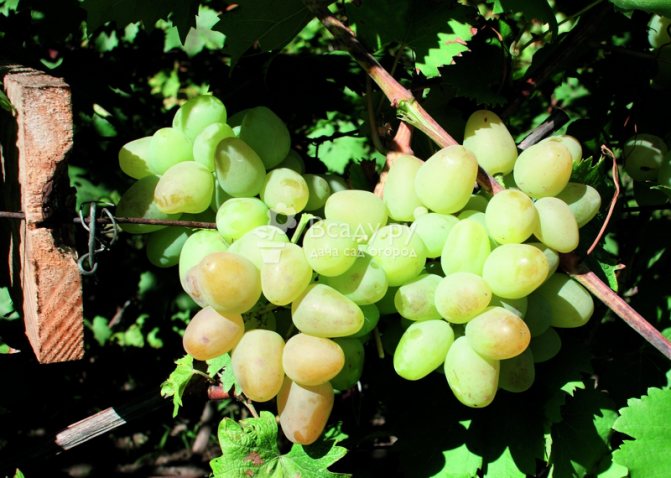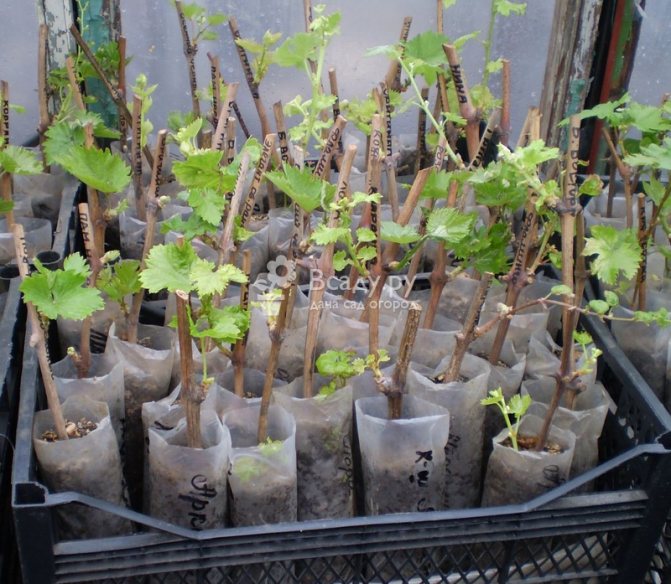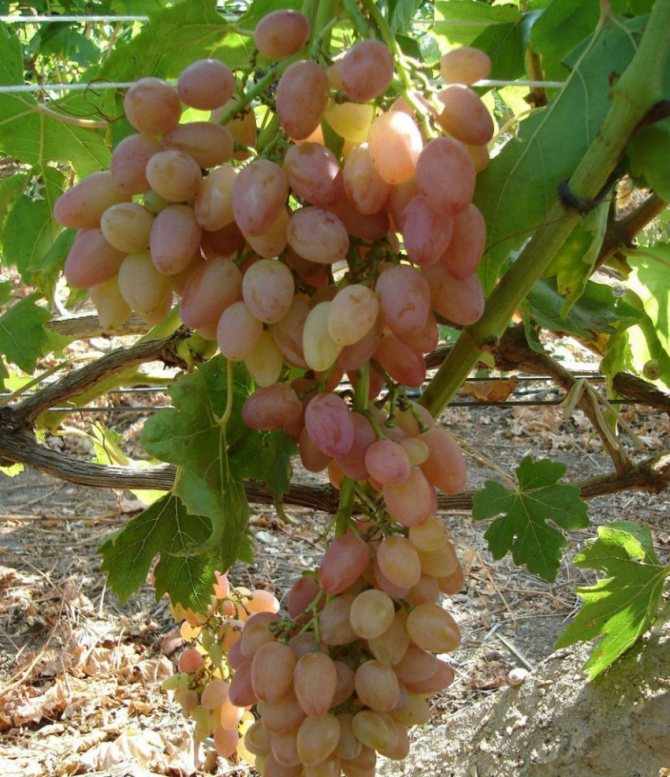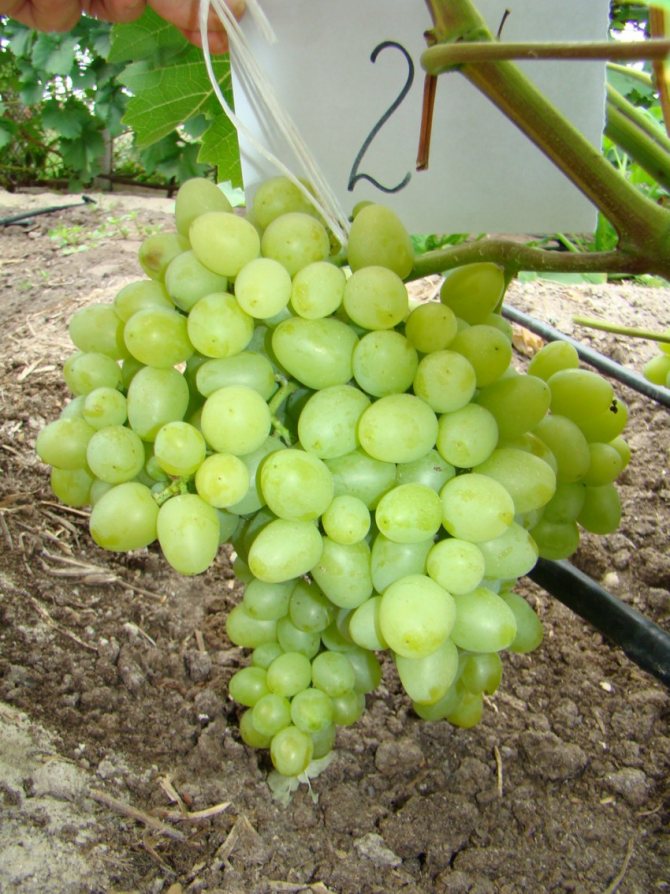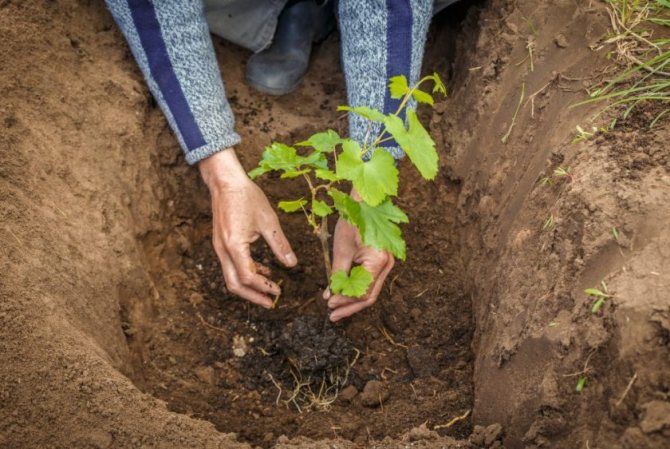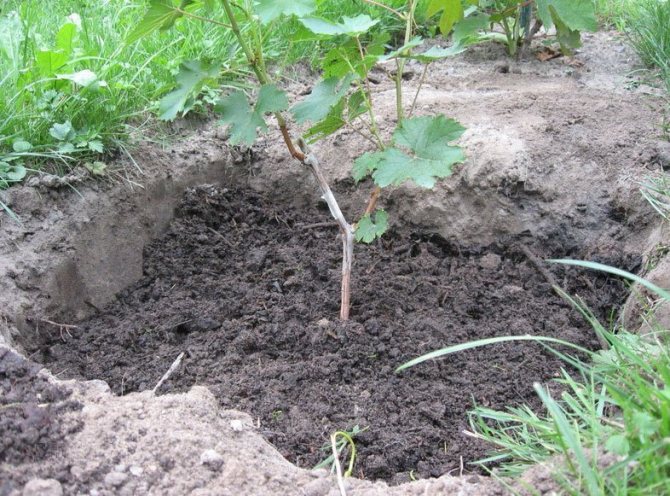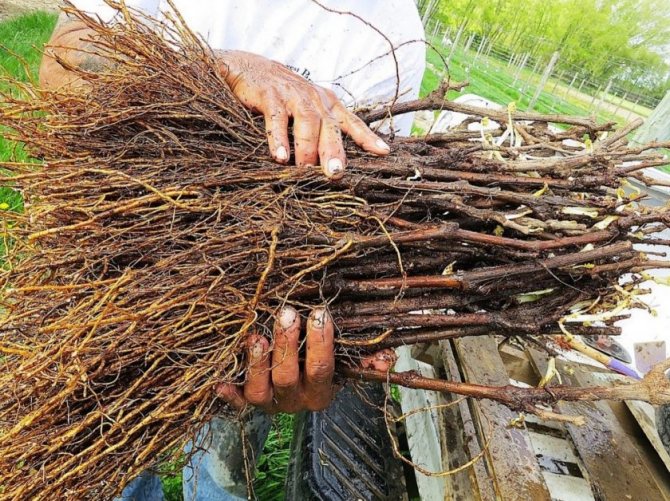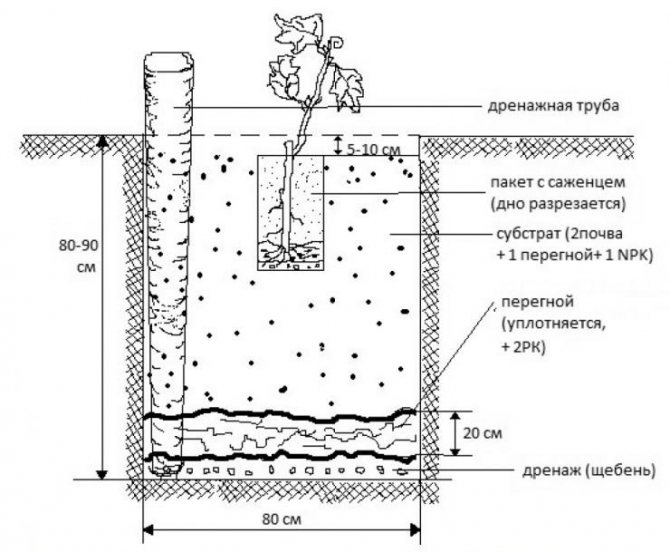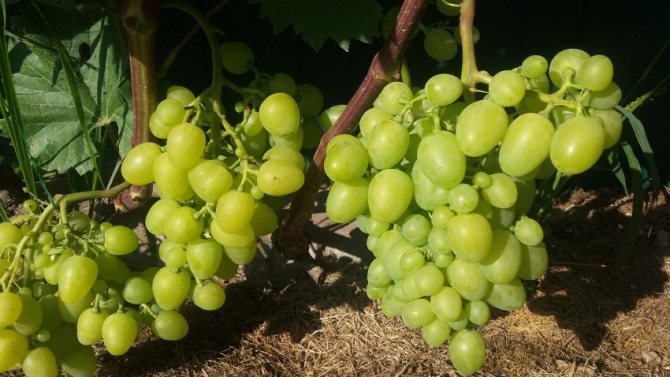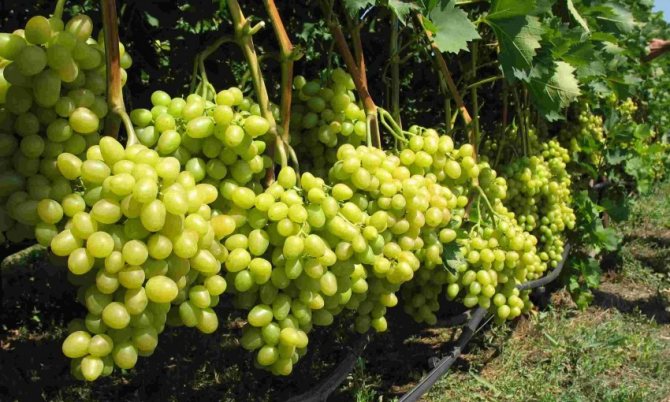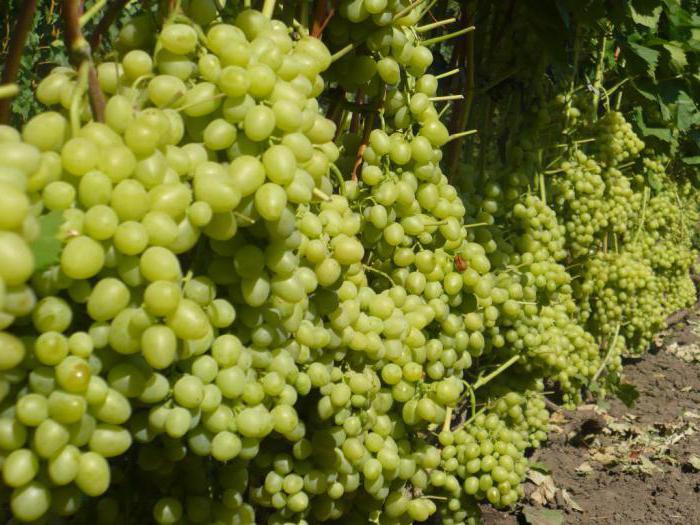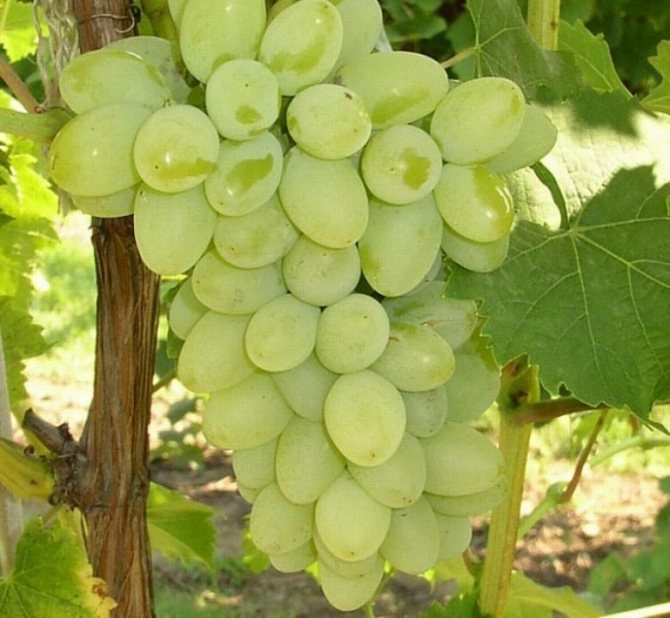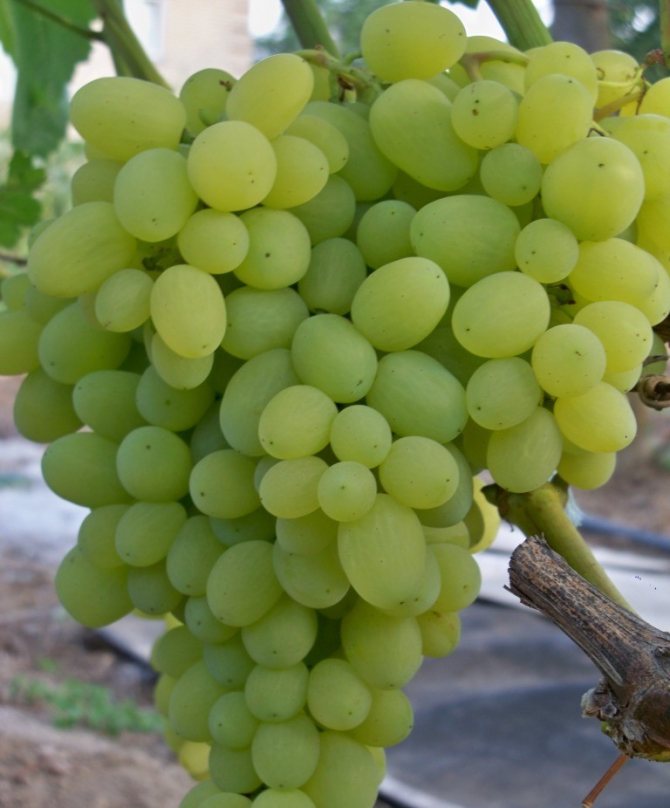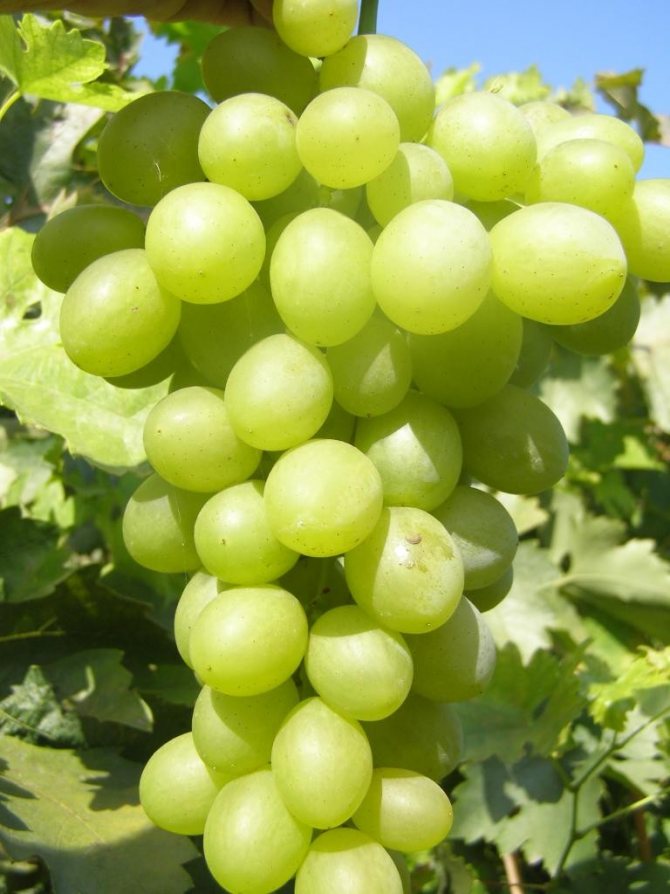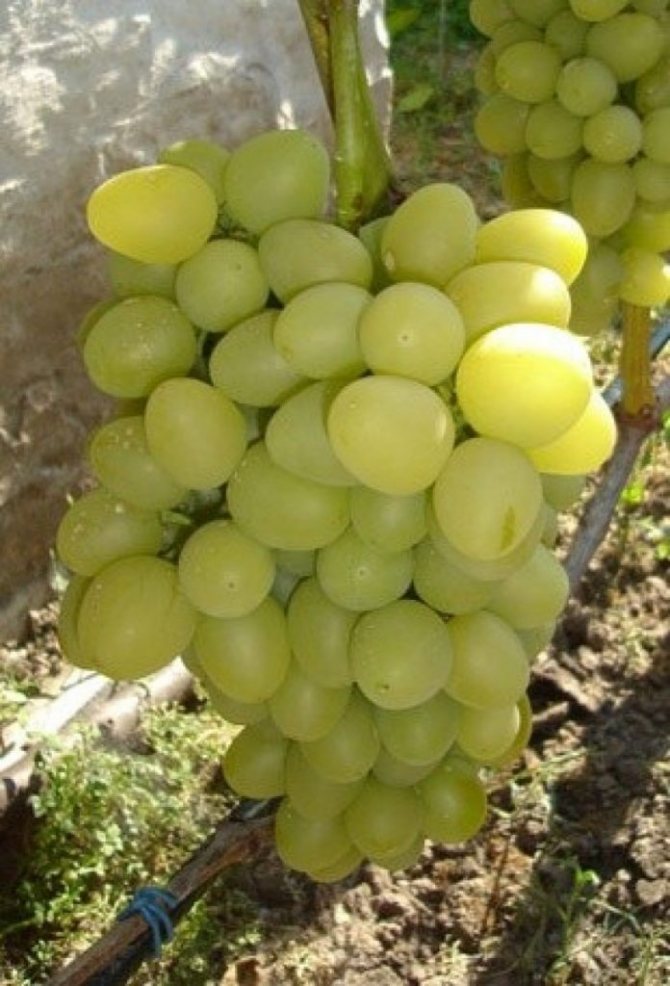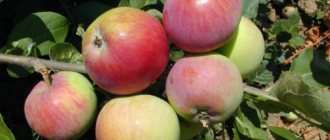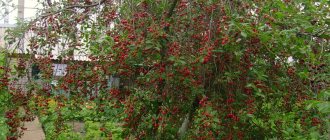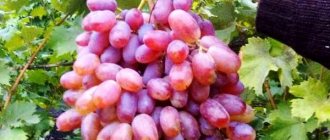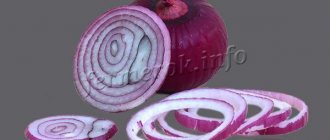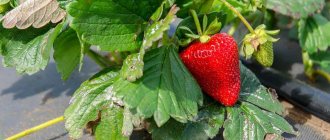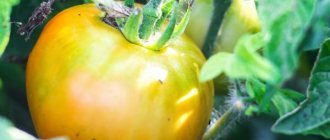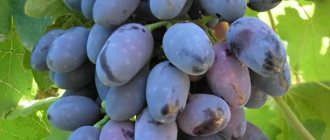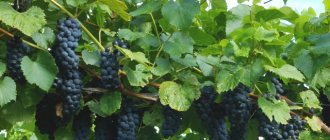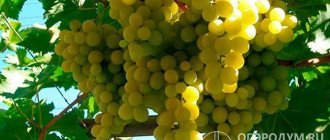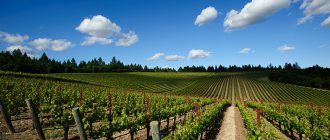Description of the Arcadia variety
Arcadia grape is a table variety of early ripening. The bush is vigorous, the vine develops quickly. Plant height is about 2.5 meters. The fruiting vine makes up 60-70% of the bush. The leaves are dissected into 5 parts, they are large, light green in color with shine. There is a light fluff on the back of the leaf.
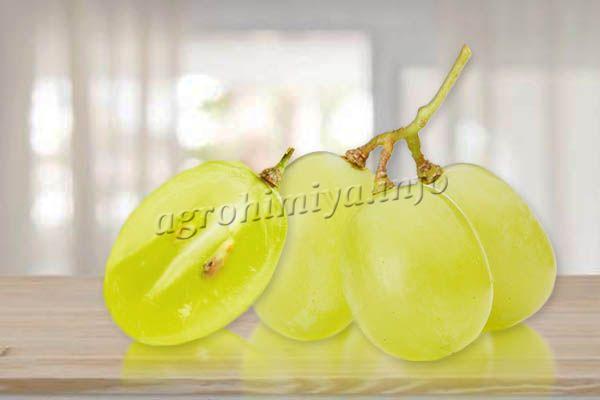
The shape of the berries is round or ovoid, the flesh is fleshy with an abundance of juice
The weight of the bunch is on average 500-700 g. The record holders can reach 2.5 kg. A bunch of conical shape, medium density with abundant branching. The berries can grow up to 12-15 g. The shape of the berries is round or ovoid. At technical maturity, the skin is white or pale yellow, but upon reaching biological maturity, the berries become amber. There is a light waxy coating. The rind is firm, but edible. The pulp is fleshy, with an abundance of juice. The taste is sweet, balanced with nutmeg aroma.
Interesting!
Despite the fact that the "parents" of Arcadia have a dark berry skin, this variety has a light green skin.
Characteristics of Arcadia grapes
Check out these articles as well
- Fertilizer Baikal EM-1
- How to plant a plum
- Fertilizer Zdraven
- Fungicide Fitosporin
It is possible to understand the characteristics of the variety, its advantages and disadvantages only after studying the characteristics. Below are the main features of the variety.
- Early ripening grapes.
- The ripening time of the first crop depends on the planting method. If cuttings or grown seedlings were used for planting, then in the second year after planting, signal clusters can be observed. All but 1-2 are torn down for a test. Thus, the bush is given additional time for root development. If grapes are grown through grafting, then already in the second year a large harvest can be harvested.
- Flowers are bisexual. So the bush pollinates itself. It can also be used as a pollinator for other varieties like Talisman, Laura.
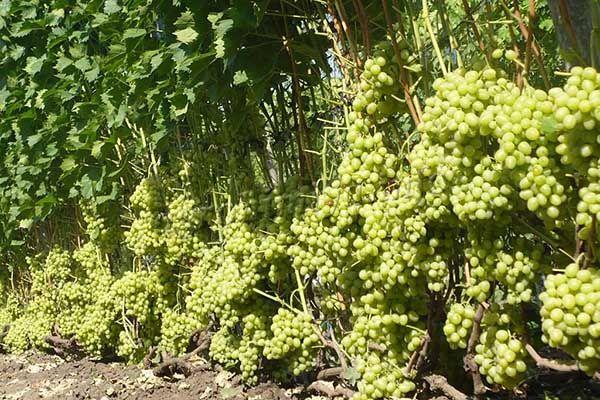

The yield per bush reaches 30-50 kg
- Productivity from a bush reaches 30-50 kg.
- There is resistance to frost up to -26 ... -28 degrees Celsius.
- The bunches are suitable for transportation over short and long distances.
- There is immunity to mildew, but at the same time, the bush can often be affected by powdery mildew and gray rot.
- The bunches and berries are pleasing in appearance, which is why this variety is often grown for sale.
- The berries can be peas.
- Bushes do not tolerate high soil moisture, waterloggedness.
- Tasters highly appreciate the taste of Arcadia grapes. It contains 14-16% sugars, and the acids are about 6 g / l.
Given these features of the variety, it is not surprising that it is loved by gardeners in different countries of Asia and Europe.
Disadvantages of the variety and requirements for growing
During the growing season and active flowering, Arcadia does not tolerate cold drafts, therefore it is recommended to plant in lowlands, providing high illumination of the vine, which has a positive effect on increasing yields.
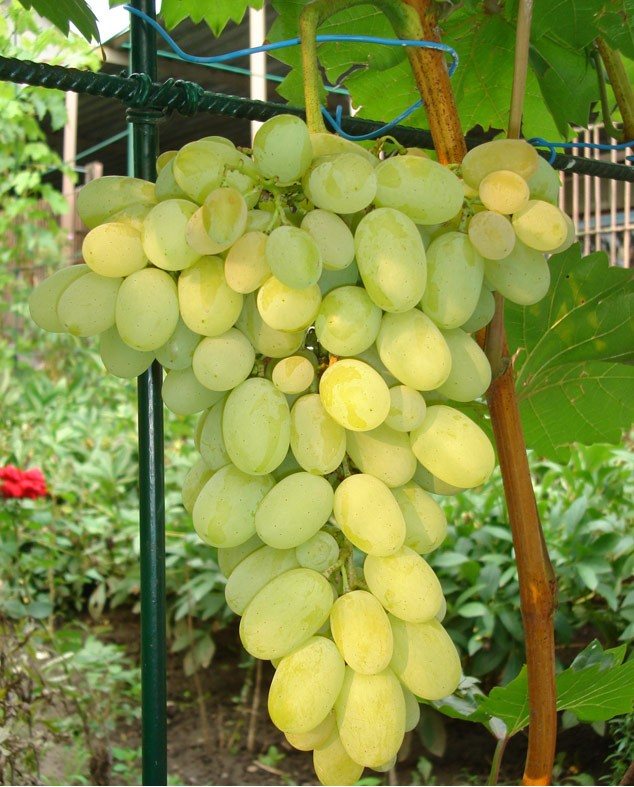

Experienced gardeners recommend correctly pruning the shoots, when a large number of bunches are formed, the berries become smaller, and in the rainy season of fruiting, the fruits crack, which leads to the loss of most of the harvest, the grapes are susceptible to gray rot.
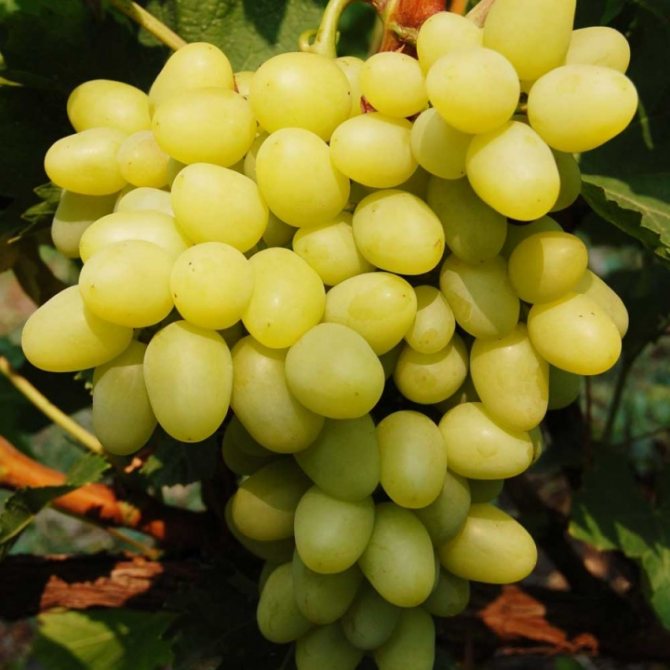

Varieties of Arcadia
There are two varieties of Arcadia grapes with their own unique characteristics.
- Arcadia pink Is a variety with pink-purple berries. This grape has a brighter, more pronounced taste, but the berries themselves are smaller in size. Ripening occurs half a month later than the classic variety.
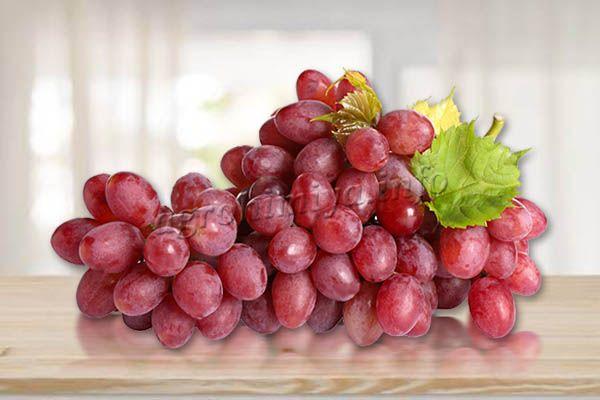

Photo of pink Arcadia
Important!
Arcadia pink grapes have resistance to cracking of berries at high humidity.
- Arcadia early ripens in just 105-110 days. The variety is resistant to powdery mildew, almost not affected by wasps. But at the same time, this Arcadia has smaller bunches, berries and low resistance to frost.
Varieties of Arcadia are grown on a par with the classic variety. Of course, each species has its own unique qualities, but experts note that both the original and its two varieties are very beneficial in growing.
How to plant grapes
We recommend reading our other articles
- Herbicide Meister Power
- Fertilizer Bona Forte
- How to grow a violet from a leaf
- Herbicide Herbitox
The place for planting Arcadia grapes is chosen sunny, where there will be a lot of light and heat. Unlike many other grape varieties, Arcadia does not tolerate cold winds well. It is for this reason that it is most often planted with some kind of natural defense. The land should be fertile, drained with a low level of groundwater.
Saplings for planting are selected healthy, strong, without damage. Before planting, you need to sprout into the solution of the growth stimulator "Kornevin" for several hours. In this case, it will take root faster.
Important!
Before planting a seedling of Arcadia grapes, it is worth installing a support on which the bush will be located. It must be strong and stable to support the weight of an adult bush vine.
It is best to plant grapes in spring, when the earth warms up to +10 degrees, and the air temperature will be above +15. At lower temperatures, planting these grapes is not recommended, because young seedlings may simply die without having time to root. If the growing region is southern, planting can be carried out in the fall 1-1.5 months before the onset of frost.
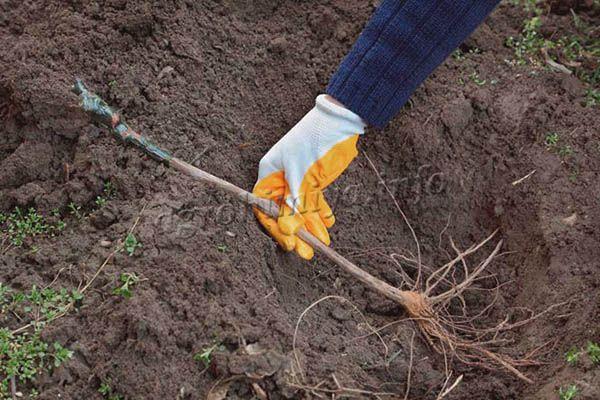

It is best to plant grapes in spring, when the ground warms up to +10 degrees, and the air temperature will be above +15
A pit for planting is dug with a depth and diameter of 70 cm. If several plants are planted nearby, then you need to make a distance between the pits of 1.5-2 meters. Drainage is poured at the bottom in a layer of 10-15 cm. Fertile soil is poured on top, composed of simple earth, humus, a small amount of minerals, and a bucket of water is poured to make the mixture thicken.
Next, a little more earth is poured, a slide is made from it and a seedling is placed on it. If the roots are large, they are straightened in all directions so that they do not bend, but if they are small, then you just need to align the seedling so that it is located evenly. You need to fill up the roots from all sides, in layers, pressing the ground with your palms. After planting, abundant watering and mulching of the root zone is carried out.
Important!
In the case of grape propagation by grafting, the stalk is set in the cleft of the healthy base of the bush. Then the connection is tied with a cloth and covered with garden varnish or wax for reliability.
Correct fit
Half of the success of growing is healthy seedlings and a properly chosen, prepared planting site.
How to choose quality seedlings when buying
Arcadia is grown with lignified cuttings. It is best to buy seedlings in nurseries from the age of 12 months.
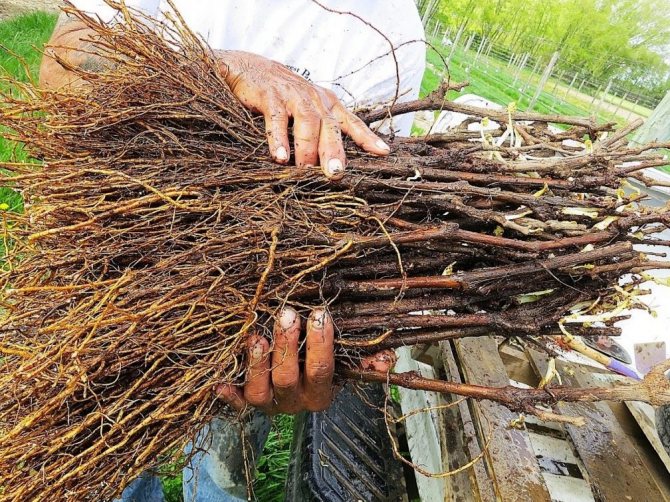

Criteria for choosing a healthy material:
- the root cut of a healthy cutting is white;
- the stem under the layer of bark should be green;
- the kidneys do not fall off from a light touch and do not peel off;
- the root system is moist and developed.
Where to plant on the site
A well-lit and wind-protected area should be selected for the culture. The location of groundwater must be at least 2.5 m from the surface of the earth. The soil for Arcadia needs fertile, loose, with good carrying capacity. Before planting, the heavy soil is dug up with the introduction of organic fertilizers (4 kg / 1 m²).
Important! Severe waterlogging of the soil can provoke root diseases. In addition, excess moisture will lead to crushing of the berries.
How to plant
The timing of planting lignified cuttings ranges from March to May inclusive, depending on the climate in the region.
Before planting, the seedlings need to be prepared:
- Cut off the shoot, leaving 1 cm to the first eye (there should be 4–5 buds on the seedling in total).
- Soak for a day in a solution of water and honey (1 l / 1 tbsp. L.), Which will help activate the growth of roots.
- Dip the upper part of the cuttings in paraffin melted in a water bath (up to + 75 ° С). This will keep from drying out and keep the early opening of the eyes.
- Shorten the roots by 1 cm.
A hole is dug up to 80 cm deep and 70 cm wide, drainage from fine gravel is placed on the bottom, then a mixture of fertilizers: half a bucket of manure and 0.5 kg of charcoal.
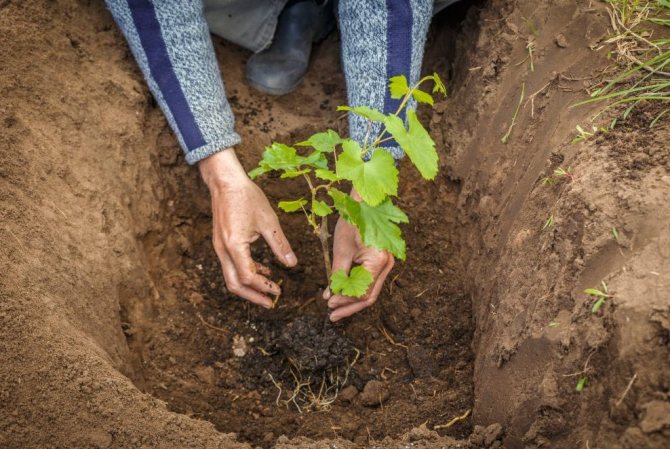

Landing technology:
- A pile of soil is poured over the fertilizer.
- The seedling is placed in the hole, spreading the roots.
- Then the soil is poured, lightly tamping.
- When buried in the soil, a new shoot growth point is left on the surface, since the cuttings do not have a root collar.
- After planting, the tree-trunk circle is abundantly watered and mulched with sawdust or straw.
- When planting several plants, a distance of 2 m is left between the pits.
Video: how to plant grape seedlings
Arcadia grape care
In care, the Arcadia grapes are demanding, so it is not suitable for beginners who have not previously grown table grape varieties.
- Daily watering is not needed. The grapes are watered as the top layer of the soil dries up. It is important to take into account that this variety does not tolerate swampiness, so it is better to water less often, but abundantly than often and little by little. Watering is carried out at the root with settled water. If there are a lot of grapes, then it will be more convenient to use a drip irrigation system. Without fail, the bushes are watered before flowering, laying the crop and preparing the bush for winter.
Important!
During heat and drought, it is worth regularly adding water under the Arcadia grape bush. At this time, the bushes are watered 1-2 times a week, spending up to 15 liters per plant.
- To obtain regular, large yields, it is necessary to ration the harvest on the bushes every year. This allows you to reduce the load on the bush, as well as accelerate the ripening of the bunches.
- Young bushes are usually not fed, because they have enough nutrition from the fertilized soil in which they were planted, but adult bushes need to be fertilized regularly. Before flowering, nitrophosphate, boric acid or humus are added. 14 days before the formation of ovaries, it is necessary to pour a solution of potassium magnesia in combination with ammonium nitrate under the bush. And 2 weeks before harvesting, feeding is carried out with superphosphate and potassium sulfate.
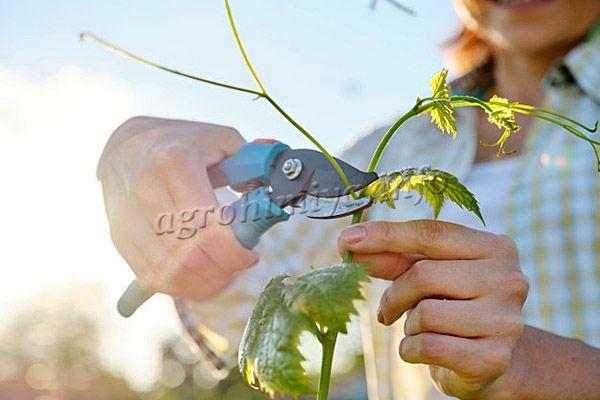

In the spring, you can cut the pagons before the sap flow begins in the vine.
- Pruning is carried out at least once a year, but it is better to do it more often. In the spring, you can cut the pagons before the flow of sap in the vine begins. In the fall, pruning is carried out in early or mid-October, before creating a reliable winter shelter. Pruning is carried out to reduce the load on the bush, renew the vine, remove all diseased, damaged, unnecessary pagons.
The Arcadia variety tolerates frosts down to -23 degrees without problems, but if the temperature drops below, it is required to build a shelter. The colder the winters, the more thoroughly the shelter is made for the winter. For medium-sized regions, where winters are moderately cold, mulch is laid under the grapes, and the bush itself is removed from the support and bent to the ground. You can cover it with agrofiber or burlap.If the winters are very cold, the bushes are first laid on the ground, then covered, covered with earth on top and again covered with protective material. In this case, the bush will be able to endure even winters at -30.
Features of seasonal care
When growing Arcadia, you need to control the amount of moisture, properly form and cut the bush. Do not forget about fertilizing and caring for the soil.
Watering
The method of watering is soil: within a radius of 50 cm from the trunk, a groove is dug, pouring an average of 2 buckets of water per bush. Watering is rare, starting from the moment the buds swell until the end of the flowering period. During the fruiting period, the plants are not watered. The procedure is resumed after harvest.
Top dressing
A young plant in the first year of life will have enough fertilizers laid during planting.
Adult plants are fertilized using the following technology:
- First feeding - before flowering with liquid mineral or organic compounds. When using manure, the solution is prepared in the proportion: 2 kg / 10 l of water / 1 m². Mineral - nitrophoska (65 g), boric acid (6 g) are dissolved in 10 liters of water.
- Second procedure - two weeks before the formation of fruit ovaries. An aqueous solution of ammonium nitrate (20 g), potassium magnesia (6 g) per 10 liters of water is prepared per 1 m².
- Third feeding - 14 days before harvest. To increase the fruit mass, add 20 g of superphosphate and potassium per 10 liters of water.
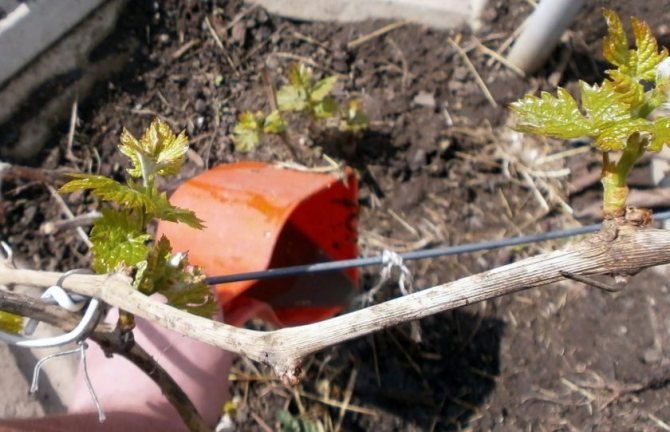

Support and garter shoots
The variety grows quickly and forms heavy clusters during fruiting, therefore it needs a garter on a support. The trellis method is used: the supports are installed at a distance of 3 m from each other. The first row of rope stretched between them is fixed at a distance of 50 cm from the ground. As the bush grows, usually in the second year after planting, the vine is tied to the bottom row of the trellis. The rows of ropes have a distance of 30–40 cm between each other.
Soil care
The trunk circle and planting aisles should be kept clean. Weeds should be regularly weeded, which draw moisture and nutrients from the soil. Weeding is combined with loosening to saturate the soil with oxygen. To preserve moisture and prevent overheating, the soil around the bush is covered with mulch.


You can use the materials that are at hand:
- forest moss;
- sawdust;
- straw;
- freshly cut grass.
Pruning
A young bush is initially formed into 2-3 stems, removing weak shoots.
Subtleties of the procedure:
- After winter, the bush may have rotted under cover or frozen shoots. They must be removed before the start of sap flow, so that the plant spends energy only on feeding healthy and strong shoots.
- In the summer, the whiskers that appear are removed, which hinder the ripening of the fruits, taking away moisture and nutrition.
- In autumn, to facilitate wintering, the vine is cut off, leaving a total of up to 30–35 eyes.
Cold protection
For the winter, the stems of young bushes are spud, creating a mound 30 cm high. In regions with severe winters, they are additionally covered with agrofibre or coniferous branches (spruce branches). An adult vine can do without shelter in moderate winter temperatures. In regions with frosty winters, the vine must be removed from the trellis, bent to the ground, and then covered with straw and spruce branches.
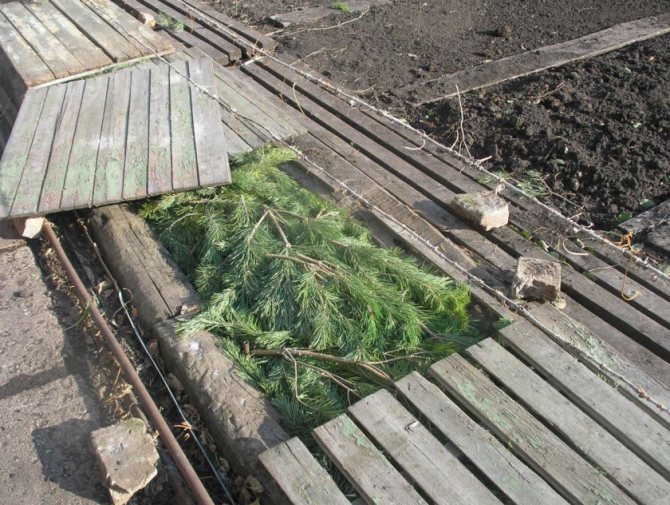

Reproduction of Arcadia
Arcadia grapes can be propagated in two ways. Each of them has its own advantages.
- Graft cuttings on a healthy adult bush. Grafting is beneficial in that the bush begins to bear fruit earlier. A year after grafting, the vine begins to actively develop and gives a decent harvest.
- Planting seedlings... In this case, the advantage is that such a plant will produce bountiful yields. The taste of the berries of such grapes is always rich, bright, and when grafted, it may not justify expectations.
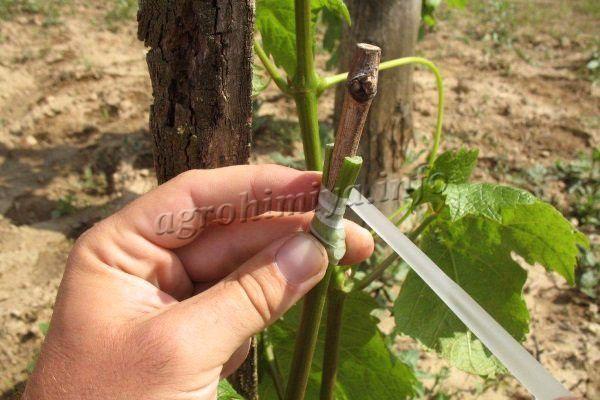

Grafting grapes is beneficial in that the bush begins to bear fruit earlier.
Regardless of the breeding method, planting material is purchased from nurseries or from professional breeders, which can provide a quality guarantee. The root system of seedlings should be white and developed. If cuttings are purchased, then on the cut they must have a healthy, green color.
Interesting!
If the root system of the purchased seedling is more than 25 cm in length, it should be cut to 10-15 cm during planting.
Diseases and pests of grapes
There is not a single grape variety that does not require treatments for diseases and pests. Even with strong immunity, this culture can get sick in bad weather, weakening of the bush, and a large harvest. Arcadia is no exception. This grape has a good immunity to mildew, but it can get sick with other diseases, so for prevention it is treated with Fitosporin, Gamair, or Alirin 2-3 times per season. In the event of an illness, it is worth using stronger drugs like Tiovit Jet, Topaz, HOM. But they are used strictly according to the instructions so as not to harm the bush.
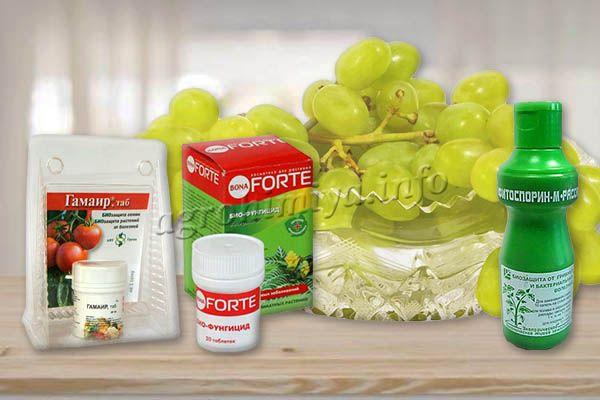

For the prevention of diseases, Arcadia is treated with Fitosporin, Gamair, or Alirin 2-3 times per season
Important!
When preparing Arcadia grapes for wintering, it is very important to carry out treatment against diseases and pests.
As for insects, they love Arcadia grapes no less than people. Among the most stubborn pests, ticks, golden beetles, weevils, leafworms are distinguished. Birds, wasps and mice also pose a major threat. Small insects can be dealt with with insecticides like Avant, Bitoxibacillin, Thunderstorm, Lepidocide. Bunches are protected from wasps and birds with the help of special protective mesh bags. As for mice, they are easy to drive away with scarers.
Appearance
The berries of Arcadia have an amber hue, which is especially surprising, since the fruits of the varieties, when crossing which this hybrid was created, have a dark purple color. If you carefully read the description of the Arcadia grape variety, it will become clear why he won the Grand Prix. One large light berry, with good care, weighs up to 16 g, and approaches 3 cm in diameter.
The fruits possess:
- low sugar content;
- slight acidity;
- juicy pulp.
The first indicator is 15%, the second ranges from 4 to 6 grams per liter. Ripening, the berries are filled with the aroma characteristic of muscat, which is successfully combined with an unusual sweetish taste.
The fruits are heart-shaped or round, covered with white prune bloom on top. Thanks to its strong, although thin skin, it is not damaged during transportation.
Even in the Poltava region, which is located in the middle climatic zone, individual clusters weigh almost 3 kg.
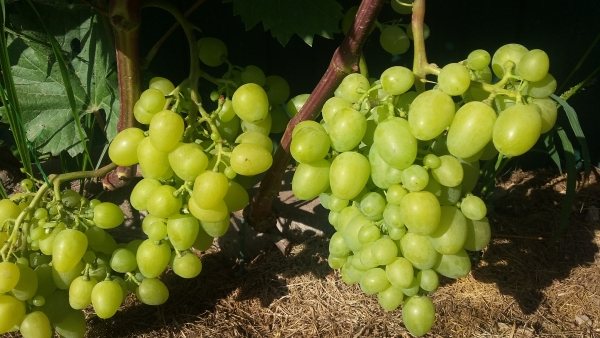

This is what ripe bunches of Arcadia grapes look like.
Harvest
Since Arcadia belongs to the early varieties, you can pick the first berries 110-120 days after bud break. But, depending on the region of cultivation, the ripening time may differ slightly. The berries ripen most rapidly in the south, and later in the northern regions. In the middle regions of Russia, Ukraine, the harvest is ready for harvest around the beginning of August.
Thanks to the dense skin and thin waxy bloom, Arcadia grapes are well stored in winter. It is best to store in a dark, cool, well ventilated area. Grapes are always stored in 1 layer.
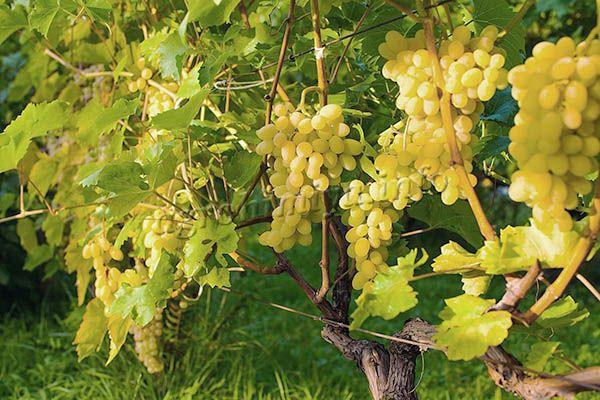

The first berries of Arcadia can be harvested 110-120 days after bud break
Arcadia berries are often used for the production of wines and juice. They can, of course, be consumed fresh. They have a pleasant, sweet taste and crunch when bitten off. In addition, the berries are quite large, beautiful, so eating them is a pleasure.
Breeding history
"Arcadia" was bred in the late 80s of the last century by Odessa breeders of the NSC of the Institute of Viticulture and Winemaking named after VE Tairova by crossing the popular "dark" table varieties: "Moldova" and "Cardinal".
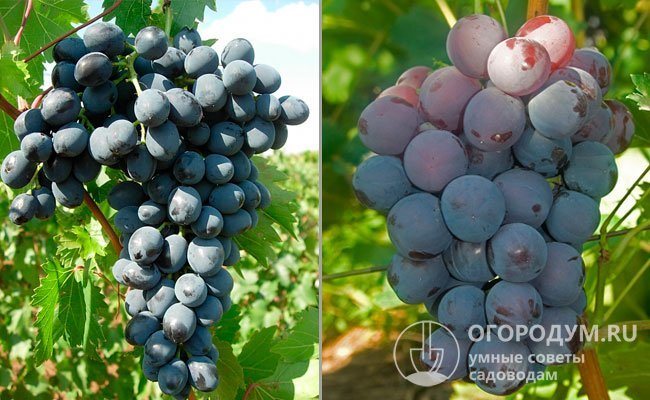

The grape varieties that served as parental forms: "Moldova" (left) and "Cardinal" (right)
After successfully conducted state tests, in 1995 "Arcadia" was officially registered in the Register of Plant Varieties of Ukraine, recommending it for cultivation in Transcarpathia, central and western regions of Odessa region. It was included in the State Register of the Russian Federation only in 2009 and allowed for cultivation in the North Caucasus region, where the soil and climatic conditions allow the variety to maximize its potential.
Over the past decade, testing of this type of culture has been regularly carried out in private agricultural lands of the western (steppe) Crimea, Kursk region (Central Black Earth region of Russia), as well as in the Zaporozhye region (Ukraine) and in Belarus.
You can learn more about the peculiarities of Arcadia from a video shot by an amateur Belarusian winegrower:
Winegrowers' reviews about the Arcadia variety
Many gardeners have heard about the characteristics, features of the Arcadia variety, but what do people think of it that they have already tried this variety in cultivation:
- Dmitry Chernovets: “I think the Arcadia variety is not bad. His harvest is excellent, grapes for any processing will go for food, too, fresh. The berries are sweet, and when overripe, they are straight sugary. But, of course, it is not easy to get such a harvest, you need to constantly look after the vineyard, regulate the harvest. If normalization is not carried out, maturation will be greatly delayed, and this is just one of the possible problems! ".
- Daniel Svyatich: “I have been growing Arcadia for many years, but then I changed it to another variety. It is, of course, ideal in terms of harvest, berry taste, but purely for yourself, it is troublesome to grow it, except for sale. There are many similar varieties that require less painstaking care, one of them and planted in the place of Arcadia. "
- Diana Kadko: “On the site I grow 10 bushes of Arcadia. I planted it for sale and did not regret it at all. It produces huge yields, even when rationed. The market for this grape is always in high demand and the price is reasonable, so it is profitable to grow it. In leaving, the truth of Arkady is demanding, if you do not feed and forget about the prevention of diseases, then the bush can not only get sick, but also die, so it is better to make a care table, and constantly follow it. "
Sapling selection
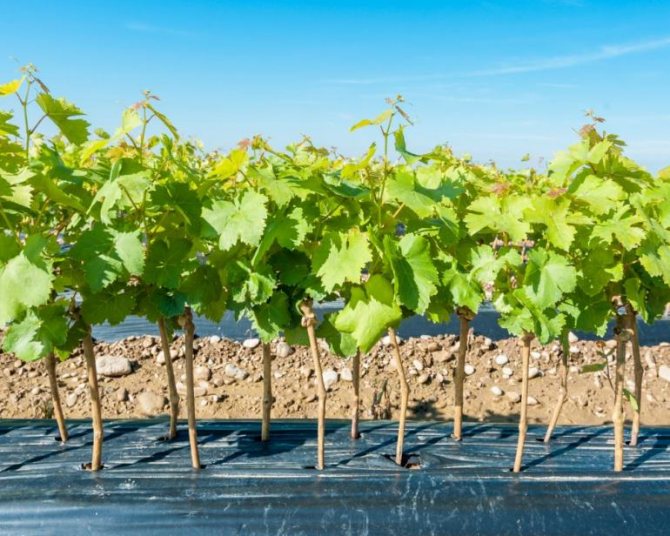

The best time to purchase seedlings is just before planting.
In order not to be disappointed in the variety, it is very important to purchase seedlings from specialized nurseries with a good reputation. Only in this case, you can avoid buying a sick, weak, defective or even a different sort of seedling.
But it is also worth paying attention that the grapes are breeding and exactly correspond to all the declared characteristics of the variety.
To do this, the seller should be asked for product certificates. Otherwise, after a couple of years of leaving and waiting, you can get not an impressive harvest of golden bunches, but stunted twigs of unknown wine varieties.
Properties of a good cutting
The acquired stalk should have leaves and a couple of eyes, look healthy and strong.
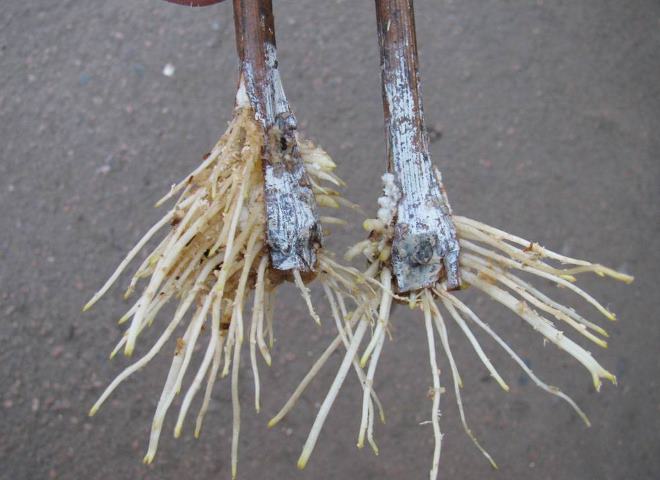

Kilchevka contributes to better root formation.
Immediately after purchase, it should be rooted in the greenhouse so that it has time to adapt to new conditions, and only then planted in a permanent place in open ground.
If there is no opportunity to purchase the coveted seedling in an agricultural firm, you should not be upset. The cutting can be asked from neighbors or friends who grow this variety. The stalk takes root very quickly in water, after which it can be transplanted into the ground and put in a warm place, not forgetting to water it periodically. A seedling grown in this way is self-rooted, less whimsical and prone to disease.However, in the winter time, he will need a reliable shelter.

